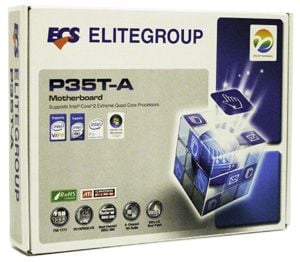Budget Core 2 Platforms from ECS and Gigabyte
Overview and Specifications
Intel’s latest chipset family, the P3x-series, can certainly be qualified as a hit thus far. While Intel P3x-series chipsets, like the mid-range P35 series and the budget-targeted P31 series, don’t sport any truly exciting new features in comparison to their previous generation counterparts, they’re showing themselves to be extremely reliable and very flexible thus far. While high-end (performance minded) buyers will most likely opt for Intel’s coming upcoming X38 and X48 chipsets, the P35 and P31 Express chipsets will no doubt become the base for the vast majority of Intel platforms over the next several years.
Currently Intel has two chipsets in the P3x family, the Intel P35 Express and the P31 Express, both targeting slightly different markets. The P35 Express is designed for higher performance platforms, with support for DDR2 or DDR3 memory, Intel Turbo memory, and Intel’s latest ICH9 series Southbridges. The P31 Express, on the other hand, is designed for mainstream and budget systems. The P31 Express only supports DDR2 memory, works in conjunction with Intel’s older ICH7 series Southbridge, and has pared-down support for things like PCI Express slots and USB ports. The lion’s share of the P35’s features are still prevalent in the P31, but the P31 also has one major advantage - price. P31 boards are selling for well south of $100 (USD), whereas most P35 Express boards are in the $100+ range.
Today at HotHardware, we’ll be looking at two budget-class Core 2 platforms based on the Intel P3x series chipsets to see if there are any differences in terms of performance between the two. Representing the P35 Express, we have the new ECS P35T-A, which retails for a little over $100 USD. In addition, we have the new Gigabyte GA-P31-DS3L representing the P31 Express. This new Gigabyte motherboard is currently selling for about 20% less (around $80 USD), making it one of the cheapest P3x boards currently on the market today.
ECS P35T-A (P35 Express) Box
|
Gigabyte GA-P31-DS3L (P31 Express) Box
|
|
|
|
|
ECS P35T-A (P35 Express)
|
Gigabyte GA-P31-DS3L (P31 Express)
|
These platforms share very similar feature sets. However, a closer look showcases the differences between these two platforms. Keep in mind, the ECS platform is about $20 to $30 more expensive at this time. What does this extra money buy you? For the most part, you’re paying for the additional benefits of the Intel ICH9-DH Southbridge on the ECS platform rather than the aging ICH7 on the Gigabyte platform. This Southbridge gives the platform two additional Serial ATA-II/300 ports and four additional USB 2.0 ports. The ECS platform also comes equipped with two PCI Express x16 sized slots, although the secondary slot only runs at x4 speeds. Also thrown into them mix is an eSATA port, which the Gigabyte board does not have.
The Gigabyte platform, on the other hand, scores as it offers official support for DDR2-1066 memory modules. Granted, the Intel P31 Express chipset only limits you to 4 GB (rather than 8 GB with the P35 Express), but Gigabyte’s additional memory flexibility comes in handy. The board also has a much better array of onboard audio ports compared to the ECS board. Frankly, it’s a tough call which platform is "better" in terms of their specifications, as it’s simply a matter of which features you’ll want in particular.










